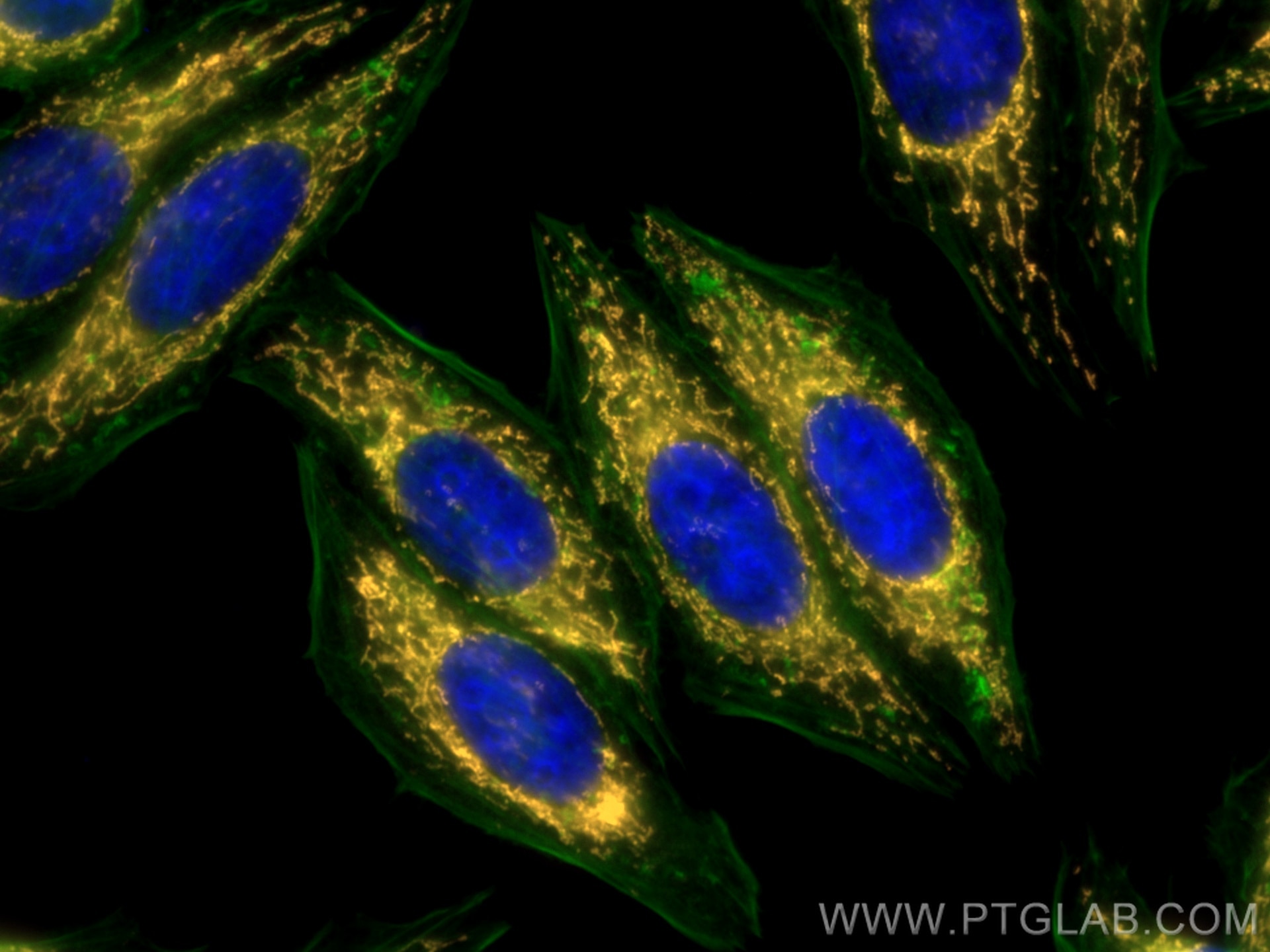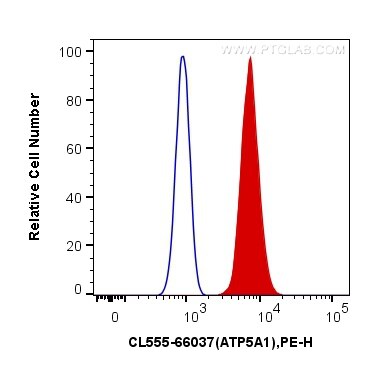- Phare
- Validé par KD/KO
Anticorps Monoclonal anti-ATP5A1
ATP5A1 Monoclonal Antibody for IF/ICC, FC (Intra)
Hôte / Isotype
Mouse / IgG2b
Réactivité testée
Humain, rat, singe, souris
Applications
IF/ICC, FC (Intra)
Conjugaison
CoraLite®555 Fluorescent Dye
CloneNo.
1B10H3
N° de cat : CL555-66037
Synonymes
Galerie de données de validation
Applications testées
| Résultats positifs en IF/ICC | cellules HepG2, |
| Résultats positifs en FC (Intra) | cellules HeLa, |
Dilution recommandée
| Application | Dilution |
|---|---|
| Immunofluorescence (IF)/ICC | IF/ICC : 1:50-1:500 |
| Flow Cytometry (FC) (INTRA) | FC (INTRA) : 0.20 ug per 10^6 cells in a 100 µl suspension |
| It is recommended that this reagent should be titrated in each testing system to obtain optimal results. | |
| Sample-dependent, check data in validation data gallery | |
Applications publiées
| FC | See 1 publications below |
Informations sur le produit
CL555-66037 cible ATP5A1 dans les applications de IF/ICC, FC (Intra) et montre une réactivité avec des échantillons Humain, rat, singe, souris
| Réactivité | Humain, rat, singe, souris |
| Réactivité citée | souris |
| Hôte / Isotype | Mouse / IgG2b |
| Clonalité | Monoclonal |
| Type | Anticorps |
| Immunogène | ATP5A1 Protéine recombinante Ag8119 |
| Nom complet | ATP synthase, H+ transporting, mitochondrial F1 complex, alpha subunit 1, cardiac muscle |
| Masse moléculaire calculée | 60 kDa |
| Poids moléculaire observé | 50 kDa |
| Numéro d’acquisition GenBank | BC064562 |
| Symbole du gène | ATP5A1 |
| Identification du gène (NCBI) | 498 |
| Conjugaison | CoraLite®555 Fluorescent Dye |
| Excitation/Emission maxima wavelengths | 557 nm / 570 nm |
| Forme | Liquide |
| Méthode de purification | Purification par protéine A |
| Tampon de stockage | PBS with 50% glycerol, 0.05% Proclin300, 0.5% BSA |
| Conditions de stockage | Stocker à -20 °C. Éviter toute exposition à la lumière. Stable pendant un an après l'expédition. L'aliquotage n'est pas nécessaire pour le stockage à -20oC Les 20ul contiennent 0,1% de BSA. |
Informations générales
The ATP5A1 gene encodes the α subunit of mitochondrial ATP synthase which produces ATP from ADP in the presence of a proton gradient across the membrane. The mitochondrial ATP synthase, also known as Complex V or F1F0 ATP synthase, is a multi-subunit enzyme complex consisting of two functional domains, the F1-containing the catalytic core and the Fo- containing the membrane proton channel. F0 domain has 10 subunits: a, b, c, d, e, f, g, OSCP, A6L, and F6. F1 is composed of subunits α, β, γ, δ, ε, and a loosely attached inhibitor protein IF1. Recently defect in ATP5A1 has been linked to the fatal neonatal mitochondrial encephalopathy. ATP5A1 is localized in the mitochondria and anti-ATP5A1 can be used as the loading control for mitochondrial or Complex V proteins. This antibody recognizes the endogenous ATP5A1 protein in lysates from various cell lines and tissues. The predicted MW of ATP5A1 is 60 kDa, while it undergoes the transit peptide cleavage to become a mature form around 50-55 kDa. Several isoforms of ATP5A1 exist due to the alternative splicing.
Protocole
| Product Specific Protocols | |
|---|---|
| IF protocol for CL555 ATP5A1 antibody CL555-66037 | Download protocol |
| FC protocol for CL555 ATP5A1 antibody CL555-66037 | Download protocol |
| Standard Protocols | |
|---|---|
| Click here to view our Standard Protocols |



